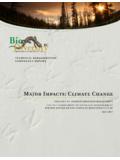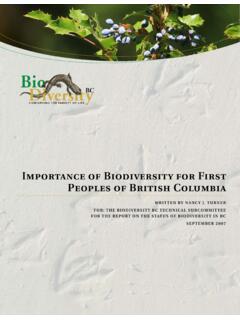Transcription of Draft S Ranks and Surrogate G Ranks for BEC Zones and ...
1 Draft S Ranks and Surrogate G Ranks for BEC Zones and Draft S Ranks for Ecoprovinces and Major Drainage Units of BC. preliminary rankings for informing the report on the status of biodiversity in bc W R I T T E N B Y L . K R E M S AT E R. FOR: THE BIODIVERSITY BC TECHNICAL SUBCOMMITTEE. F O R T H E R E P O RT O N T H E S TAT U S O F B I O D I V E R S I T Y I N B C. SEPTEMBER 2007. Draft S Ranks and Surrogate G Ranks for BEC Zones and Draft S Ranks for Ecoprovinces and Major Drainage Areas of BC: Preliminary rankings for informing the Biodiversity Status Report and Action Plan Final Draft September 2007.
2 Laurie Kremsater, Consultant (facilitator of workshop). Workshop participants: Carmen Cadrin, Conservation Data Centre Dave Clark, Ministry of Environment Dennis Demarchi, Consultant Andrew Harcombe, Nature Conservancy Canada Ted Lea, Ministry of Forests William MacKenzie, Ministry of Forests Adrian Walton, Ministry of Forests Table of Contents 1. 1. 2. 1. 3. Summary .. 10. 3. 1. Summary 10. 3. 2. Challenges and 11. 4. Developing G and S Ranks for BEC 13. 1. Boreal Altai Fescue Alpine(BAFA).. 13. 2. Bunchgrass (BG).. 14. 3. Boreal White and Black Spruce (BWBS).
3 17. 4. Coastal Douglas-fir (CDF).. 18. 5. Coastal Mountain Heather Alpine (CMA).. 20. 6. Coastal Western Hemlock (CWH ).. 22. 7. Engelmann Spruce Subalpine Fir (ESSF).. 23. 8. Interior Cedar Hemlock (ICH).. 25. 9. Interior Douglas-fir (IDF) .. 27. 10. Interior Mountain Heather Alpine (IMA) .. 28. 11. Mountain Hemlock (MH) .. 30. 12. Montane Spruce (MS).. 31. 13. PP (Ponderosa Pine).. 32. 14. Sub Boreal Pine Spruce (SBPS) .. 34. 15. Sub boreal Spruce (SBS) .. 35. 16. Spruce Willow Birch (SWB) .. 37. 5. Developing Draft S Ranks for 39. 1. Boreal Pains (BOP).
4 39. 2 Central Interior (CEI).. 40. 3. Coast and Mountains (COM).. 41. 4. Georgia Depression (GED).. 42. 5. Northern Boreal Mountains (NBM).. 44. 6. South Alaskan Mountains (SAM).. 45. 7. Southern Interior (SOI) .. 46. 8. Southern Interior Mountains(SIM) .. 47. 9. Sub Boreal Interior (SBI).. 48. 10. Taiga Plains (TAP) .. 49. 6. Developing Draft S Ranks for Major Drainage Areas In BC .. 51. 1. 51. 2. 53. 3. 54. 4. MacKenzie .. 56. 5. 57. 6. Skeena .. 58. 7. Stikine .. 59. 8. Taku .. 60. 9. 61. Appendix 1: Definition of global NatureServe G and S Ranks .. 63.
5 References:.. 64. Draft S Ranks and Surrogate G Ranks for BEC Zones and Draft S Ranks for Ecoprovinces and i Major Drainage Areas of BC. Laurie Kremsater. September 2007. 1. Introduction The Biodiversity Strategy requested that a group assign Global Ranks (G Ranks ), Provincial Ranks (S Ranks ), and Global Responsibility to Biogeoclimatic (BEC) Zones , Ecoprovinces and Major Drainage Areas. The purpose of the ranking was to provide information that would subsequently allow priorities to be assessed for various conservation activities within and among those ecological units.
6 Our work is the first attempt to rank these large ecosystems in and we attempted to follow Nature Serve methodology as far as possible. Because the NatureServe methodology was not created to rank large ecosystems, the rankings we developed cannot be considered equivalent to the NatureServe rankings for species. Our rankings are preliminary and the methodology to rank large ecosystems needs to be better developed, hence we refer to the rankings we developed as modified rankings. I was asked to facilitate a workshop to develop modified S Ranks for Biogeoclimatic Ecosystem Classification (BEC) Zones , Ecoprovinces, and Major Drainage Areas and modified G Ranks for BEC Zones .
7 The group (Carmen Cadrin, Dave Clark, Dennis Demarchi, Andrew Harcombe, Ted Lea, Will MacKenzie, and Adrian Walton) met for one day to outline the process we would use to assign the modified S and G Ranks , and completed several threat tables for BEC Zones within Ecoprovinces. That work provided the backbone for me to complete the remaining threat tables and sum the results to provide overall modified Ranks . Subsequent to the main workshop, meetings with Art Tautz and Eric Parkinson (Fisheries UBC) helped set direction and complete rankings for the Major Drainage Areas.
8 2. Methods At present there is no accepted process for developing S or G Ranks for large ecological areas. We were directed to follow NatureServe methodology as closely as possible to assign modified S Ranks for BEC Zones , Ecoprovinces, and Major Drainage Areas and also applies that approach to assigning modified G Ranks for BEC Zones . Our estimation of global range for G Ranks was mostly informed by the mapping completed for the Shining Mountains work (Demarchi et al. 2000), in the text we note where that mapping does not include the whole range of particular BEC Zones so that we had to estimate those ranges based on expert opinion.
9 The NatureServe methodology was found on the web, and in several Draft notes provided by Carmin Cadrin that are in flux as methodologies continue to change and develop. The tables we used are included below. First we focused on describing and completing a threat assessment that could be used in the NatureServe approach. We used the IUCN (June 2006) suggested list of threats (which has been adopted by NatureServe). Those threats include: 1. Residential (including housing and urban areas, commercial area, and tourism recreation areas). 2. Agriculture and aquaculture (non-timber crops, plantations, livestock).
10 3. Energy production and mining (oil and gas, mining and quarrying, renewable energy). Draft S Ranks and Surrogate G Ranks for BEC Zones and Draft S Ranks for Ecoprovinces and 1. Major Drainage Areas of BC. Laurie Kremsater. September 2007. 4. Transportation and service corridors (roads and railway, utility and service lines, seismic lines, shipping lanes, flight paths). 5. Biological resource use (hunting and collecting, logging, fishing and harvesting aquatic resources). 6. Human intrusion and disturbance (recreational activities, war and civil unrest, work).





